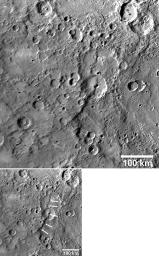Rupes, Rupes, Every Where
Caption:
Giant scarps (cliffs), called rupes (see
PIA10609
), are believed to have formed when Mercury's interior cooled and the entire planet shrank slightly as a result. This figure, recently published in
Science
magazine, shows one of these scarps (white arrows) that is about 270 kilometers (170 miles) long. This portion of Mercury's surface was seen during the Mariner 10 flybys, but this scarp, despite its large size, was not visible in the Mariner 10 photos because the Sun was nearly overhead at the time and, consequently, the scarp did not cast a discernible shadow. In contrast, MESSENGER acquired a mosaic of this area (see
PIA10605
) before the spacecraft's closest approach to the planet, when this portion of the surface was near the terminator, the line between the sunlit dayside and the dark night side of the planet. Such lighting produced long shadows, enabling this rupes to be recognized for the first time.
Date Acquired:
January 14, 2008
Image Mission Elapsed Time (MET):
Mosaic of images from 108821370, 108821375, 108821397, and 108821402
Instrument:
A: Narrow Angle Camera (NAC) of the Mercury Dual Imaging System (MDIS)
Background Info:
These images are from MESSENGER, a NASA Discovery mission to conduct the first orbital study of the innermost planet, Mercury. For information regarding the use of images, see the MESSENGER
image use policy
.
Cataloging Keywords:
| Name |
Value |
Additional Values |
| Target |
Mercury |
|
| System |
|
|
| Target Type |
Planet |
|
| Mission |
MESSENGER |
Mariner |
| Instrument Host |
MESSENGER |
Mariner 10 |
| Host Type |
Orbiter |
Flyby Spacecraft |
| Instrument |
Mercury Dual Imaging System (MDIS) |
|
| Detector |
Narrow Angle Camera (NAC) |
|
| Extra Keywords |
Grayscale, Shadow |
| Acquisition Date |
|
| Release Date |
2008-08-13 |
| Date in Caption |
2008-01-14 |
|
| Image Credit |
NASA/Johns Hopkins University Applied Physics Laboratory/Arizona State University/Carnegie Institution of Washington. Figure 4 from Solomon et al., Science, 321, 59-62, 2008. |
| Source |
photojournal.jpl.nasa.gov/catalog/PIA11012 |
| Identifier |
PIA11012 |

 Planetary Data System
Planetary Data System
